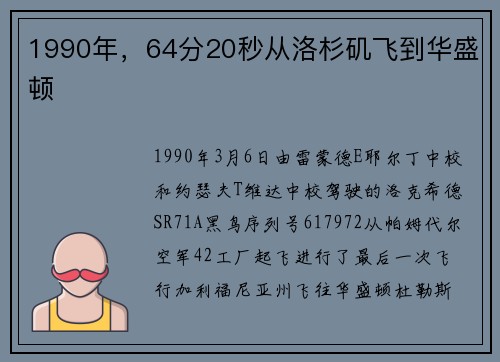1990年,64分20秒从洛杉矶飞到华盛顿

1990 年 3 月 6 日,由雷蒙德·E·耶尔丁中校和约瑟夫·T·维达中校驾驶的洛克希德 SR-71A 黑鸟(序列号 61-7972)从帕姆代尔空军 42 工厂起飞,进行了最后一次飞行 ,加利福尼亚州,飞往华盛顿杜勒斯国际机场。
这次飞行不仅标志着 SR-71 的(首次)退役,还创下了多项速度记录。

耶尔丁中校的这一天很早就开始了。
他凌晨 1:00 起床,并参加凌晨 2:00 的飞行简报会。
飞行准备工作包括在凌晨 3:45 之前穿戴好衣服并前往航线,计划于太平洋标准时间凌晨 4:30 起飞,相当于华盛顿特区东部标准时间上午 7:30。
一小群人聚集在一起,见证 SR-71 黑鸟从帕姆代尔历史性地最后一次起飞。
最初,SR-71 起飞时只装载了一半的燃油,以确保安全并在升空后发动机出现故障的情况下提供足够的爬升性能。
在 27,000 英尺的高度,飞机从太平洋上空的 KC-135Q 加油机加油。加满油箱后,耶尔丁和维达转向东,启动加力燃烧室,开始 200 英里的加速行驶。
他们以 2.5 马赫速度和 63,000 英尺的高度穿越西海岸,最终在 76,000 英尺的高度达到 3.3 马赫的巡航速度。
在飞行过程中,耶尔丁注意到加利福尼亚海岸线、洛杉矶、旧金山和圣地亚哥的能见度。
当他们继续前行时,从 78,000 英尺的高度就可以看到拉斯维加斯、米德湖和大峡谷等地标建筑。
飞机飞越了派克峰和科罗拉多山脉,穿越了广阔的农田,其速度和高度使得这趟旅程与 150 年前拓荒者所花费的几个月相比显得微不足道。
该航班从东海岸到西海岸的航段用时 67 分 54 秒完成,其中洛杉矶至华盛顿特区的航段用时 64 分 20 秒。
乐鱼全站官网SR-71 在从海岸到海岸的飞行中平均速度超过 2,125 英里/小时,从洛杉矶飞往华盛顿特区的平均速度为 2,145 英里/小时。
穿过威尔明顿并向华盛顿特区下降后,黑鸟在左转时从超音速减速,并在 25,000 英尺的高度遇到另一架 KC-135Q 进行额外加油。
抵达杜勒斯国际机场后,耶尔丁和维达进行了两次低空飞行(其中一次带有加力燃烧室),以展示排气羽流中的冲击钻石。
然后,他们摇动机翼敬礼,并在着陆时打开阻力伞。
这次最后的飞行不仅展示了SR-71的非凡能力,也体现了飞行员和机组人员对这架飞机及其所服务的国家的尊重和钦佩。

在完成这次创纪录的飞行后,这架尾号为 972 的飞机正式退役,后来转移到史密森尼国家航空航天博物馆的史蒂文·F·乌德瓦尔·哈齐中心,至今仍在那里展出。
An SR-71 once flew from LA to DC in 64 minutes and 20 seconds.
On March 6, 1990, Lockheed SR-71A Blackbird, serial number 61-7972, piloted by Lt. Col. Raymond E. Yeilding and Lt. Col. Joseph T. Vida, embarked on its final flight from Air Force Plant 42 in Palmdale, California, to Washington Dulles International Airport.
This flight not only marked the (first) retirement of the SR-71 but also set multiple speed records.
The day began early for Lt. Col. Yeilding.
He woke up at 1:00 AM and attended a flight briefing at 2:00 AM.
Preparation for the flight involved suiting up and moving to the flight line by 3:45 AM, with takeoff planned for 4:30 AM PST, corresponding to 7:30 AM EST in Washington, D.C.
A small crowd gathered to witness the historic last takeoff of an SR-71 Blackbird from Palmdale.
Initially, the SR-71 took off with only half a load of fuel to ensure safety and provide sufficient climb performance in case of an engine failure just after liftoff.
At 27,000 feet, the aircraft refueled from a KC-135Q tanker over the Pacific Ocean.
After topping off the fuel tanks, Yeilding and Vida turned east, engaged the afterburners, and began a 200-mile acceleration run.
They crossed the West Coast at Mach 2.5 and 63,000 feet, eventually reaching a cruise speed of Mach 3.3 at 76,000 feet.
During the flight, Yeilding noted the visibility of the California coastline, Los Angeles, San Francisco, and San Diego.
As they continued, landmarks like Las Vegas, Lake Mead, and the Grand Canyon were visible from an altitude of 78,000 feet.
The aircraft passed Pike’s Peak and the Colorado mountains, crossing vast farmlands at speeds and altitudes that made the journey seem minute compared to the months it took pioneers 150 years before.
The coast-to-coast segment of the flight was completed in 67 minutes and 54 seconds, with the specific Los Angeles to Washington, D.C. leg taking 64 minutes and 20 seconds.
The SR-71 averaged speeds over 2,125 mph for the coast-to-coast flight and 2,145 mph from Los Angeles to D.C.
After crossing Wilmington and descending toward Washington, D.C., the Blackbird decelerated from supersonic speeds in a left-hand turn and met another KC-135Q for additional refueling at 25,000 feet.
Upon arrival at Dulles International, Yeilding and Vida performed two low passes—one with afterburners—to showcase the shock diamonds in the exhaust plumes.
They then rocked the aircraft's wings in salute and deployed the drag chute as they landed.
This final flight not only demonstrated the SR-71's extraordinary capabilities but also encapsulated the pilots and crew's respect and admiration for the aircraft and the country it served.
After completing this record-setting flight, the aircraft, Tail Number 972, was officially retired and later moved to the Smithsonian National Air and Space Museum’s Steven F. Udvar-Hazy Center, where it remains on display today.